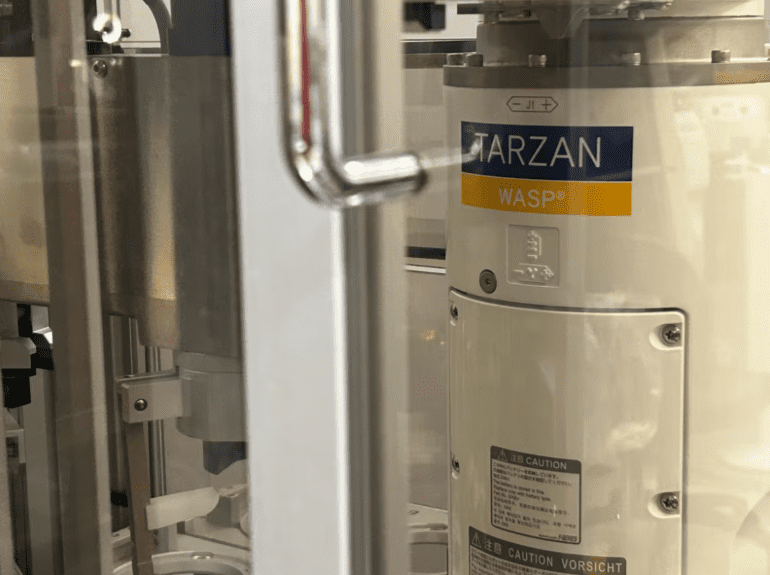TL;DR:
- AI-powered robots, Tarzan and Jane, are streamlining microbiology sample processing at St. Paul’s Hospital in Vancouver.
- These robots handle up to 70% of the hospital’s samples, improving efficiency and freeing up lab staff.
- The $1-million automated WASPLab uses AI to assess and categorize culture plates, reducing manual work.
- Dr. Marc Romney praises the robots’ contributions and highlights their role in complex medical workflows.
- Despite initial apprehensions, these robots enhance rather than replace human healthcare professionals.
- Copan, an Italian lab automation manufacturer, created and customized Tarzan and Jane for St. Paul’s Hospital.
- The hospital plans to implement another WASPLab in 2027 when a new facility opens.
- AI is transforming healthcare but will complement, not replace, human medical professionals.
Main AI News:
In the latest technological advancement at St. Paul’s Hospital in downtown Vancouver, AI-driven robots are quietly revolutionizing the medical laboratory landscape. Termed “Tarzan” and “Jane,” these sophisticated machines are taking on the mundane yet crucial task of processing up to 70 percent of the hospital’s microbiology samples with the precision of AI-driven automation.
The hospital’s recently installed $1-million automated WASPLab, aptly named the “walk-away specimen processor,” is a shining example of how artificial intelligence is transforming the healthcare industry. While lab automation is not a novelty, WASPLab’s pioneering use of AI in Western Canada sets a new standard for efficiency and accuracy. These robots assess and categorize culture plates, segregate bacterial cultures, and promptly alert staff when further analysis is warranted.
Dr. Marc Romney, the head of medical microbiology and virology at St. Paul’s, extols the benefits of this automation, which liberates medical professionals from repetitive manual tasks. Tarzan and Jane have proven themselves as invaluable additions to the lab, capable of working tirelessly during early mornings and late shifts, and efficiently managing large batches of samples.
“The more routine work, which is sometimes very manual, is being replaced by a robot,” states Dr. Romney. This shift not only streamlines workflows but also provides healthcare workers with greater flexibility to focus on more intricate tasks.
Initial apprehensions among the lab staff were natural when the robot duo first arrived. Many wondered if their jobs were at risk, fearing these machines might replace them. However, as Dr. Romney attests, it became clear that Tarzan and Jane were here to simplify their lives, not take their place.
Each robot plays a distinct role in the microbiology process. Tarzan excels at the “heavy lifting,” handling specimen preparation and bar code scanning. Meanwhile, Jane is an adept artisan, precisely applying specimen volumes to bacterial culture plates. Afterward, these plates are tagged, stored in an incubator, and left to nurture bacterial colonies.
The true magic happens during incubation, where WASPLab’s artificial intelligence takes charge. The system autonomously discards negative culture plates while highlighting positive ones. This crucial step, once manual and time-consuming, now proceeds seamlessly thanks to Tarzan and Jane’s automated precision.
These robots, created by Italy-based lab automation manufacturer Copan, have been meticulously tailored to meet St. Paul’s Hospital’s requirements through months of collaboration with doctors and laboratory staff. Generously funded by a donor to the St. Paul’s Foundation, this cutting-edge system is a testament to the ongoing innovation in healthcare.
However, it is worth noting that even the most advanced technology isn’t infallible. Dr. Romney acknowledges that these robots can occasionally make errors, such as Tarzan dropping tubes. As in real life, complex technology sometimes falters, necessitating human intervention to rectify mistakes.
Looking ahead, St. Paul’s Hospital plans to implement another WASPLab when the new facility opens in 2027. The question of whether robots and AI could entirely replace human staff in healthcare settings is raised, but Dr. Romney believes that both will play significant roles without completely supplanting medical professionals.
While automated systems excel most of the time, they still have their limitations. Dr. Romney asserts that AI will enable the next generation of physicians to focus on more complex tasks, yet acknowledges the increasing acuity and complexity of patients’ needs, making it harder for AI to provide definitive answers without human intervention. In the ever-evolving landscape of healthcare, AI is undoubtedly a pivotal player, but it remains a complementary tool rather than a complete replacement.

Romney points to an image taken with a new machine to help the microbiology lab at St. Paul’s Hospital in Vancouver. Source: Ethan Cairns/THE CANADIAN PRESS
Conclusion:
The integration of AI-driven robots like Tarzan and Jane at St. Paul’s Hospital exemplifies how automation can significantly enhance efficiency and reduce manual work in healthcare laboratories. This technological advancement highlights the potential for AI in the healthcare market to streamline processes, improve accuracy, and free up medical professionals for more complex tasks, all while acknowledging that AI is a complementary tool rather than a complete replacement for human expertise.

